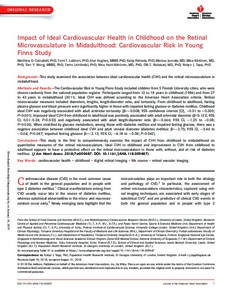Impact of Ideal Cardiovascular Health in Childhood on the Retinal Microvasculature in Midadulthood: Cardiovascular Risk in Young Finns Study
Matthew D. Campbell; Tomi T. Laitinen; Alun Hughes; Katja Pahkala; Markus Juonala; Mika Kähönen; Tien Y. Wong; Terho Lehtimäki; Nina Hutri-Kähönen; Olli T. Raitakari; Robyn J. Tapp
https://urn.fi/URN:NBN:fi-fe2021042822749
Tiivistelmä
Background-This study examined the association between ideal cardiovascular health (CVH) and the retinal microvasculature in midadulthood.
Methods and Results-The Cardiovascular Risk in Young Finns Study included children from 5 Finnish University cities, who were chosen randomly from the national population register. Participants ranged from 12 to 18 years in childhood (1986) and from 37 to 43 years in midadulthood (2011). Ideal CVH was defined according to the American Heart Association criteria. Retinal microvascular measures included diameters, lengths, length: diameter ratio, and tortuosity. From childhood to adulthood, fasting plasma glucose and blood pressure were significantly higher in those with impaired fasting glucose or diabetes mellitus. Childhood ideal CVH was negatively associated with adult arteriolar tortuosity (beta=-0.008; 95% confidence interval [CI], -0.01 to -0.003; P=0.001). Improved ideal CVH from childhood to adulthood was positively associated with adult arteriolar diameter (beta=0.122; 95% CI, 0.01-0.24; P=0.033) and negatively associated with adult length: diameter ratio (beta=-0.666; 95% CI, -1.25 to -0.08; P=0.026). When stratified by glucose metabolism, among those with diabetes mellitus and impaired fasting glucose, there was a negative association between childhood ideal CVH and adult venular diameter (diabetes mellitus: beta=-2.75; 95% CI, -5.46 to -0.04; P=0.047; impaired fasting glucose: beta=-2.13; 95% CI, -4.18 to -0.08; P=0.042).
Conclusions-This study is the first to comprehensively examine the impact of CVH from childhood to midadulthood on quantitative measures of the retinal microvasculature. Ideal CVH in childhood and improvement in CVH from childhood to adulthood appears to have a protective effect on the retinal microvasculature in those with, without, and at risk of diabetes mellitus.
Kokoelmat
- Rinnakkaistallenteet [27094]
